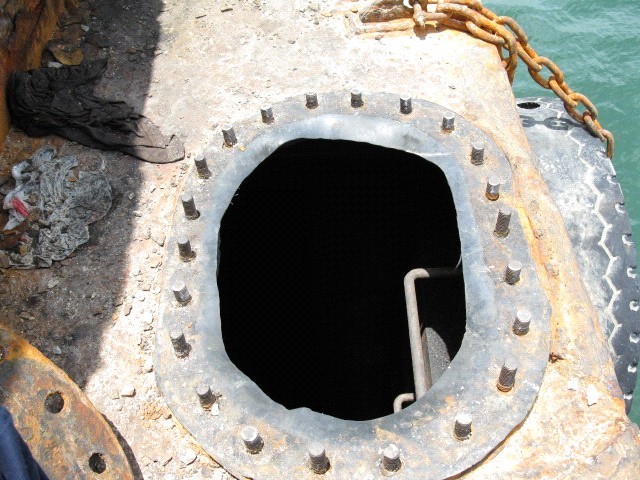Spot The Safety Violation: Avoid 4 Confined Space Mistakes
If workers had to enter this manhole on a barge, what kinds of protections should be in place’

Confined spaces, such as tanks, silos, ditches, excavations, etc., are one of the most serious safety hazards in a workplace. That’s because when something goes wrong in a confined space, the consequences are often fatal. In fact, every year, workers are seriously injured or die when the confined spaces they’re working in flood, the walls collapse or they’re overcome by toxic gases’and about 60% of the workers killed in confined spaces are would-be rescuers coming to the aid of others.
This picture was taken of a barge that docked in Singapore. After a crew member went missing, a search of the vessel ultimately found his body (along with that of another man) inside this manhole. They were pronounced dead at the scene.
This tragedy is similar to one that occurred on a barge in BC. Workers were carrying out a variety of repairs on the barge, including repairs to manholes that access void compartments in the hull (see picture below).

A supervisor went missing and another worker found him in the bottom of a compartment in the hull. Three other workers, one by one, entered the compartment to rescue their co-workers and lost consciousness. Ultimately, four workers died from oxygen deprivation. Another worker and a firefighter were injured in the rescue attempt.
AVOID THESE 4 CONFINED SPACES MISTAKES
The areas in these two pictures would be considered confined spaces under the OHS laws because they:
- Are completely or partially enclosed;
- Aren’t designed or intended for continuous human occupancy but large enough for a worker to enter;
- Have restricted or limited means of entrance and exit; and
- Are or may become hazardous to anyone entering them because of their design, location, etc.
As confined spaces, the OHS laws across Canada would require employers to take certain precautions to protect any worker who had to work in them.
To protect your workers in confined spaces, make sure you avoid these mistakes:
Mistake #1: Failing to identify confined spaces. Confined spaces can be found in many types of workplaces in various industries. So it’s important to identify confined spaces, such as void compartments in ship hulls, so you can ensure that you have the appropriate safety measures in place for work in such spaces.
Mistake #2: Failing to have a confined space program. If there are confined spaces in your workplace or which your workers may have to work in, you should have a confined space program that includes assessment of the hazards related to those spaces’such as inadequate oxygen levels’and implementation of appropriate safety measures to address the identified hazards, such as an entry permit system.
For example, the employer of the workers involved in the BC barge incident didn’t have a confined space program. So workers entered the confined space without pre-entry air testing being conducted or mechanical ventilation.
Mistake #3: Not having confined space attendants present. When workers entered the confined space on the BC barge there was no standby person or confined space attendant there to monitor the work and conditions or to summon help. So make sure that you train workers to serve as confined space attendants.
Mistake #4: Not having a rescue plan. As noted above, many of the workers who die in confined space incidents are trying to rescue other people. For example, in the BC incident, there was no confined space rescue plan in place, which contributed to the deaths of three workers who tried to save their colleagues. Having an emergency and rescue plan to protect workers in confined spaces as well as anyone who tries to come to their aid will help prevent such fatalities.
For more information and tools to help you protect workers in confined spaces and comply with the OHS laws, go to the OHS Insider’s Confined Space Compliance Centre.